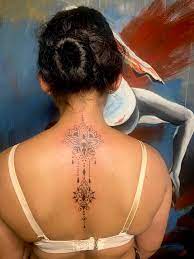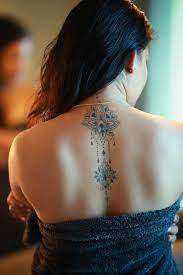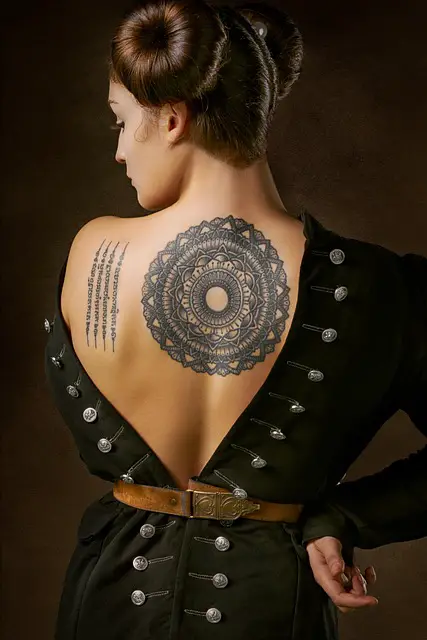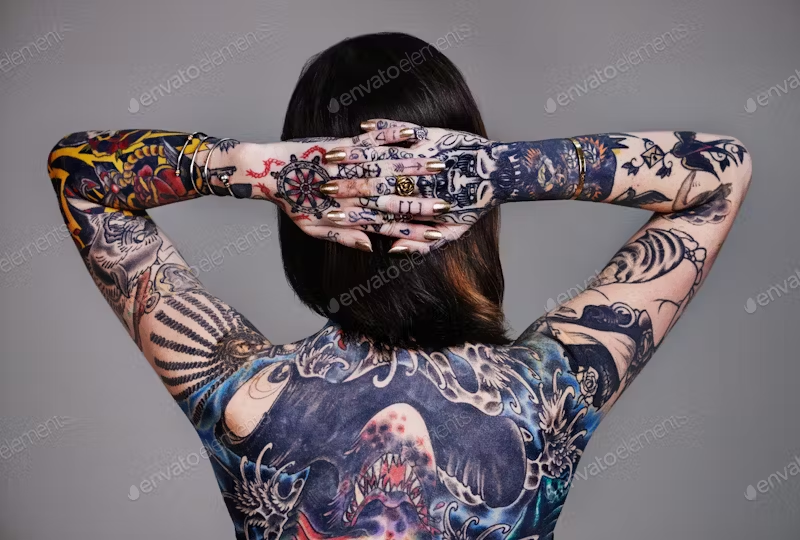Contents
Nair on tattoos
The allure of smooth, hair-free skin is often a priority for many individuals, but what happens when this desire collides with the canvas of body art? This article delves into the intriguing yet potentially risky territory of using hair removal cream, notably Nair, on tattooed skin.
Introducing the Dilemma:
Tattoos, intricate forms of self-expression, demand special care during their healing phases. The consideration of using hair removal products like Nair on these adorned areas raises critical questions about potential consequences.
The Temptation and the Caution:
While the promise of effortless hair removal is tempting, it comes with its share of caution. This article aims to shed light on the risks and concerns associated with the seemingly innocuous act of applying hair removal cream to tattooed skin.
Balancing Aesthetic Desires and Skin Health:
A delicate balance must be struck between the aesthetic desire for smooth skin and the imperative to preserve the integrity of the tattooed canvas. As we embark on this exploration, it becomes essential to understand the intricacies and potential pitfalls of this beauty ritual.
Understanding Tattoos and Skin Sensitivity
The Artistry of Tattooing:
Tattooing is a profound form of self-expression, where ink becomes an indelible part of one’s identity. The process involves puncturing the skin with needles to deposit ink into the dermis layer, creating a lasting masterpiece.
Sensitivity of Tattooed Skin:
Tattooed skin is not just a static canvas; it’s a healing work in progress. During the initial days and weeks after getting a tattoo, the skin is particularly sensitive. The body works diligently to repair and regenerate the wounded area, making it susceptible to external influences.
The Crucial Healing Phase:
Understanding the healing phases of tattoos is paramount. Initially, the skin undergoes inflammation and scabbing, followed by a period of peeling. Applying hair removal cream during these stages can disrupt the natural healing process and potentially compromise the vibrancy and longevity of the tattoo.
Need for Special Care:
Tattooed skin demands special care and consideration. The fragility of the healing process means that any product applied to the skin must be chosen with utmost care. Hair removal creams like Nair, with their chemical composition, pose a unique set of challenges when introduced to this sensitive environment.
Preserving the Art:
Preserving the intricate details and vibrant colors of a tattoo requires a mindful approach. As we explore the potential impact of Nair on tattooed skin, it becomes essential to acknowledge the delicate balance needed to achieve hair removal goals without jeopardizing the artistic investment beneath the surface.

Composition of Hair Removal Creams
Common Ingredients in Hair Removal Creams:
Hair removal creams, including Nair, typically contain a blend of active and inactive ingredients. Common components include calcium thioglycolate, potassium hydroxide, mineral oil, and fragrance. These ingredients work in harmony to break down the protein structure of hair, allowing for easy removal.
Active Ingredients in Nair:
Nair, a well-known hair removal brand, features active ingredients like calcium hydroxide and potassium hydroxide. These alkali substances play a crucial role in breaking down the keratin in hair, effectively dissolving it at the surface level.
How Hair Removal Creams Work:
The chemical action of hair removal creams is twofold. Calcium thioglycolate, a reducing agent, weakens the disulfide bonds in keratin, altering its structure. Simultaneously, potassium hydroxide, an alkaline compound, works to dissolve the weakened hair, making it easy to wipe or wash away.
Challenges for Tattooed Skin:
While these chemical processes are effective for hair removal, the challenge arises when these creams come into contact with tattooed skin. The sensitivity of the healing skin and the intricate balance of pigments in a tattoo can be disrupted by the potent chemical reactions that occur during the hair removal process.
Potential Impact on Tattooed Areas:
The concern lies in the potential impact on the tattooed areas. The alkali nature of the active ingredients may interact with tattoo pigments, leading to fading or alterations in color. Additionally, the overall integrity of the tattoo may be compromised if the chemical action interferes with the healing process.
Need for Caution and Selectivity:
As we scrutinize the composition of hair removal creams, it becomes evident that caution and selectivity are crucial when considering their application on tattooed skin. The delicate balance of achieving hair removal goals while preserving the artistry beneath necessitates a thoughtful approach. In the next section, we will delve into the specific risks and potential effects that using Nair on tattoos may entail.
Risks and Potential Effects on Tattoos
Fading of Vibrancy:
One of the foremost risks associated with using Nair on tattoos is the potential fading of vibrant colors. The chemical interaction between the active ingredients in Nair and the tattoo pigments can lead to a gradual loss of intensity and brilliance.
Discoloration Concerns:
Beyond fading, there’s a real concern for discoloration. The delicate balance of hues that makes a tattoo visually striking can be compromised as the alkali nature of Nair interacts with the pigments. This may result in unexpected shifts in color and an overall distortion of the intended tattoo design.
Texture Alterations:
The chemical action of Nair isn’t limited to color concerns; it extends to potential alterations in texture. The delicate healing process of a tattoo involves the development of a smooth, even surface. The use of Nair, with its potent chemical reactions, may disrupt this process and lead to unintended changes in the texture of the tattooed skin.
Compromised Healing Process:
Applying Nair during the healing stages of a tattoo can compromise the natural recovery process. The skin’s response to the chemical onslaught may lead to increased inflammation, prolonged peeling, or other complications. This not only impacts the appearance but also the overall health of the tattooed area.
Importance of Preservation:
The very essence of a tattoo lies in its permanence and the artistry it represents. Using Nair on tattoos jeopardizes this permanence by introducing factors that can diminish the quality and longevity of the ink. Preserving the integrity of the tattoo becomes paramount to ensure it remains a timeless expression of individuality.
A Thoughtful Approach:
As we uncover these potential risks, it becomes evident that a thoughtful and informed approach is essential when contemplating hair removal in tattooed areas. The desire for smooth skin should not come at the cost of compromising the artistic investment beneath the surface.
Emphasizing Preservation:
Preservation becomes the guiding principle. Preserving the vivid hues, the intricate details, and the overall aesthetic appeal of a tattoo requires a conscious effort to avoid unnecessary risks. In the subsequent sections, we will explore safer alternatives and considerations for maintaining the balance between grooming and the artistry of tattoos.
Adverse Reactions and Allergies
Chemical Sensitivity and Allergic Risks:
Using Nair on tattooed skin introduces the potential for adverse reactions and allergies. The chemicals in Nair, particularly calcium hydroxide and potassium hydroxide, can trigger sensitivity in some individuals. Allergic reactions range from mild irritation to more severe responses.
Sensitivity of Healing Skin:
Tattooed skin, especially during the healing phases, is inherently more sensitive. The delicate balance of the healing process can be disrupted by the introduction of potent chemicals. This heightened sensitivity increases the risk of adverse reactions when Nair comes into contact with the healing or recently tattooed skin.
Common Allergic Responses:
Common allergic responses to Nair may include redness, itching, swelling, and a burning sensation. These symptoms can be more pronounced on healing skin, where the body is actively working to repair and regenerate tissue. Disruption of this process can amplify the impact of allergic reactions.
Potential for Complications:
Applying Nair on tattooed skin not only poses risks to the tattoo itself but also increases the potential for complications related to skin health. Allergic reactions can lead to inflammation, which, when combined with the healing process of a tattoo, may result in a more prolonged and uncomfortable recovery.
Why Healing Skin Reacts Stronger:
The body’s response to foreign substances is heightened during the healing phase of a tattoo. The skin is in a state of regeneration, making it more susceptible to external influences. Allergic responses that might be relatively mild on normal skin can become more pronounced and troublesome when introduced to healing or recently tattooed areas.
Cautious Approach During Healing:
A cautious approach is crucial during the healing stages of a tattoo. This involves not only avoiding potential risks to the tattoo but also minimizing the chances of adverse reactions. Opting for gentler grooming methods that do not introduce potent chemicals can contribute to a smoother healing process.
As we navigate the potential for adverse reactions and allergies, the preservation of the tattoo remains a central concern. Choosing grooming methods that prioritize the well-being of the healing skin ensures that the artistic investment beneath the surface is protected.
In the Next Section: Safer Alternatives and Considerations:
In the subsequent sections, we will explore safer alternatives for hair removal on tattooed skin and delve into considerations that balance the desire for smooth skin with the imperative to preserve the quality and appearance of tattoos.

Safer Alternatives for Hair Removal
Mindful Grooming Choices:
Making mindful choices when it comes to hair removal in tattooed areas is pivotal for both grooming goals and tattoo preservation. Safer alternatives ensure that the desire for smooth skin doesn’t compromise the integrity of the artistic investment beneath.
Shaving:
Shaving stands out as a reliable and gentle alternative for hair removal on tattooed skin. It allows for precise control, minimizing the risk of chemical interference. When approached with care, shaving can be a safe method that doesn’t compromise the vibrant hues or intricate details of a tattoo.
Hair Trimmers:
Hair trimmers offer another safe avenue for grooming in tattooed areas. These devices provide a controlled and precise trimming experience without the need for potent chemicals. The risk of interference with tattoo pigments or the healing process is significantly reduced when opting for this method.
Avoidance of Chemical Products:
The key principle is to avoid chemical-laden products, especially during the healing phases of a tattoo. Chemical hair removal creams, including Nair, should be set aside during this crucial period to prevent potential risks to both skin health and the tattoo itself.
Precautions During Healing:
While practicing safer alternatives, it’s essential to exercise caution during the healing stages of a tattoo. The skin is still in a delicate state, and any grooming method should be approached with gentleness. Patience is crucial in allowing the tattoo to undergo its natural healing process without unnecessary disruptions.
Regular Monitoring and Care:
Regularly monitor the tattooed area for signs of healing and ensure that grooming practices do not cause undue stress to the skin. Gentle cleaning and moisturizing can contribute to a smoother healing journey while addressing grooming needs.
Consultation with Professionals:
When in doubt or if specific concerns arise, seeking guidance from tattoo artists or dermatologists is advisable. These professionals can provide personalized advice based on the unique characteristics of the tattoo and the individual’s skin.
Holistic Approach to Skin Health:
Adopting a holistic approach to skin health ensures that grooming practices align with the overall well-being of tattooed skin. By choosing safer alternatives and exercising care during grooming, individuals can enjoy the benefits of smooth skin without compromising the lasting impact of their tattoos.
Next Section: Considerations for Maintaining Balance:
In the following sections, we will explore additional considerations for maintaining the delicate balance between grooming preferences and the artistry of tattoos. The goal is to foster an understanding of how to navigate this intersection with informed choices and a commitment to both skin and tattoo health.
Waiting for Full Tattoo Healing
Crucial Patience During Healing:
One of the fundamental principles for preserving both the quality of a tattoo and the health of the skin is exercising patience. Waiting until tattoos are fully healed before venturing into any hair removal methods is crucial for the seamless and successful integration of grooming practices.
Understanding the Healing Phases:
Tattoos undergo distinct phases of healing, each with its own set of considerations. From the initial inflammation and scabbing to the subsequent peeling and settling, the full healing journey can take several weeks. Introducing grooming methods, especially those involving potential irritants, during these phases can disrupt the natural progression.
Postpone Chemical Interactions:
The healing skin is particularly sensitive to external influences. Postponing chemical interactions, including the use of hair removal creams like Nair, until the tattoo has completed its healing process is a prudent approach. This minimizes the risk of adverse reactions, discoloration, or alterations in texture.
Typical Healing Duration:
While the exact healing duration can vary based on factors such as tattoo size, location, and individual skin characteristics, a general guideline is to anticipate a healing period of 2 to 4 weeks. However, it’s crucial to note that the full maturation of the skin and complete stabilization of the tattoo may extend beyond this initial period.
Signs of Full Healing:
Signs of full healing include the absence of scabs or peeling, the skin regaining its normal texture, and the vibrancy of the tattoo being fully restored. These indicators suggest that the skin has undergone the necessary regeneration and is less susceptible to potential disruptions caused by grooming practices.
Consulting with Tattoo Professionals:
Tattoo artists play a pivotal role in guiding individuals through the healing process. Consulting with tattoo professionals and seeking their input on the readiness of the tattooed area for grooming activities ensures a more informed decision-making process. Their expertise can provide personalized insights based on the unique characteristics of each tattoo.
Respecting the Tattoo’s Journey:
Respecting the journey of the tattoo is tantamount to ensuring its longevity and visual appeal. Waiting until the tattoo is fully healed aligns with a commitment to preserving the artistic investment beneath the skin’s surface.
Next Steps: Informed Grooming Choices:
As we emphasize the significance of waiting for full tattoo healing, the subsequent sections will delve into the next steps of making informed grooming choices. This involves considering the unique characteristics of tattoos and adopting practices that complement the artistry beneath the surface.

Expert Recommendations and Professional Advice
Seeking Guidance from Tattoo Professionals:
The journey of maintaining both smooth skin and vibrant tattoos involves seeking guidance from those with expertise. Tattoo artists, being intimately familiar with the intricacies of the tattooing process and aftercare, stand as valuable resources. Encouraging readers to consult with their tattoo artists ensures access to personalized advice based on the unique characteristics of their tattoos.
Dermatological Expertise for Skin Health:
Dermatologists, as specialists in skin health, provide a second layer of professional insight. Their expertise encompasses the broader context of skincare, considering factors beyond the artistic aspects of tattoos. Encouraging readers to seek advice from dermatologists ensures a holistic approach to skin health, especially when contemplating grooming practices.
Importance of Aftercare Instructions:
Following aftercare instructions provided by tattoo artists is a fundamental aspect of preserving both the tattoo and the skin. These instructions are tailored to the specific needs of the tattoo and include guidelines for cleaning, moisturizing, and protecting the area during the healing process. Emphasizing the importance of adherence to aftercare instructions contributes to a successful tattoo healing journey.
Professional Guidance for Specific Concerns:
Tattoos, like any form of body modification, can present unique challenges and concerns. For readers with specific worries about grooming practices, potential reactions, or the integration of hair removal methods, obtaining professional guidance becomes paramount. Whether through consultations with tattoo artists or dermatologists, seeking advice for specific concerns ensures a more nuanced and informed approach.
Adapting Grooming Practices to Individual Needs:
Every individual’s skin and tattoo experience is unique. Expert recommendations allow for a personalized approach to grooming practices. By adapting these practices to individual needs, readers can strike a balance between their desire for smooth skin and the imperative to preserve the integrity of their tattoos.
Building a Relationship with Professionals:
Building a relationship with tattoo artists and dermatologists fosters an ongoing dialogue about skin health and tattoo maintenance. Regular consultations enable individuals to stay informed about the latest recommendations and best practices in both tattoo aftercare and grooming methods.
Holistic Approach to Skin and Tattoo Care:
The collaboration between individuals, tattoo artists, and dermatologists contributes to a holistic approach to skin and tattoo care. By seeking expert advice and incorporating it into grooming routines, readers can navigate the intersection of grooming preferences and the lasting impact of their tattoos with confidence.
Next Section: Informed Decision-Making:
In the subsequent sections, we will explore the practical aspects of making informed decisions about grooming practices, ensuring that the desire for smooth skin aligns harmoniously with the commitment to preserving the visual allure and longevity of tattoos.
Real-life Experiences and Cautionary Tales
Learning from Real-life Narratives:
The intersection of grooming practices and tattoos has seen its share of real-life narratives—stories that serve as cautionary tales and valuable lessons. These experiences shed light on the potential consequences of using Nair on tattoos and underscore the importance of making informed decisions.
Fading Colors and Discoloration:
Some individuals have shared stories of vibrant tattoo colors gradually fading after the application of Nair. The once vivid hues lost their intensity, leading to a noticeable shift in the overall appearance of the tattoo. Discoloration became a tangible consequence, altering the visual impact of the inked design.
Unintended Texture Changes:
Cautionary tales have surfaced regarding unintended texture changes in tattooed skin. The chemical action of Nair, when introduced to healing or recently tattooed areas, disrupted the smooth, even texture that is a hallmark of well-healed tattoos. The consequence was a deviation from the desired outcome of both hair removal and tattoo preservation.
Heightened Allergic Reactions:
Real-life experiences have highlighted heightened allergic reactions when Nair came into contact with healing tattooed skin. Individuals shared accounts of increased redness, persistent itching, and swelling, emphasizing the susceptibility of the healing skin to allergic responses triggered by the potent chemicals in Nair.
Prolonged Healing Periods:
Anecdotes have surfaced detailing prolonged healing periods associated with the use of Nair on tattoos. The disruption caused by chemical reactions extended the natural healing process, subjecting individuals to discomfort and complications that could have been avoided with a more cautious approach.
Regret and Tattoo Preservation:
Some narratives express regret over not seeking professional advice before incorporating Nair into grooming routines. These individuals wished they had consulted with their tattoo artists or dermatologists, emphasizing the importance of expert guidance in navigating the delicate balance between hair removal goals and tattoo preservation.
Personal Reflections on Informed Choices:
Real-life experiences serve as poignant reminders of the need for careful consideration and informed choices. These cautionary tales underscore that the desire for smooth skin should be aligned with a commitment to preserving the artistic investment beneath. Readers can draw insights from these narratives to make decisions that prioritize both grooming preferences and the longevity of their tattoos.
In the Next Section: Empowering Informed Decision-Making:
In the upcoming sections, we will empower readers with practical insights and considerations. By incorporating lessons from real-life experiences, individuals can navigate the realm of grooming practices with a heightened awareness of the potential consequences and a commitment to making choices that contribute to the lasting allure of their tattoos.
Conclusion
In navigating the delicate balance between grooming preferences and the longevity of tattoos, this exploration has uncovered crucial insights into the potential risks associated with using Nair on tattooed skin. As we summarize the key points, it’s essential to reflect on the overarching theme of preserving the health and vibrancy of tattoos through informed decision-making.
Balancing Smooth Skin and Tattoo Preservation:
The desire for smooth skin and the commitment to preserving the artistic investment beneath the surface necessitate a thoughtful approach. Achieving this balance requires an understanding of the potential risks posed by hair removal creams like Nair and the impact they can have on healing or recently tattooed skin.
Chemical Interactions and Consequences:
Chemical interactions between Nair and tattooed skin can lead to a range of consequences, including fading of colors, discoloration, unintended texture changes, and heightened allergic reactions. Real-life experiences and cautionary tales serve as poignant reminders of the potential risks and encourage a cautious and informed decision-making process.
Patiently Waiting for Full Healing:
Waiting until tattoos are fully healed before considering any hair removal methods is a fundamental principle. The healing phases of a tattoo demand patience, and introducing grooming practices, especially those involving potent chemicals, during this sensitive period can disrupt the natural progression and compromise the quality of the tattoo.
Seeking Expert Recommendations:
Expert recommendations from tattoo artists and dermatologists play a pivotal role in guiding individuals through the nuanced intersection of grooming and tattoo preservation. Encouraging readers to seek professional advice ensures that decisions align with both the desire for smooth skin and the imperative to maintain the integrity of their tattoos.
Empowering Informed Decision-Making:
Real-life experiences and cautionary tales serve as beacons of wisdom, empowering readers to make informed decisions about their grooming practices. Personal reflections and anecdotes highlight the importance of individualized care, emphasizing that the desire for smooth skin can harmoniously coexist with the commitment to preserving the lasting allure of tattoos.
In conclusion, let this exploration be a guide for readers embarking on the journey of grooming and tattoo care. By prioritizing informed decision-making, respecting the healing process, and seeking expert advice, individuals can navigate the delicate balance with confidence, ensuring that their tattoos stand as timeless expressions of self-expression and artistry beneath the surface.





